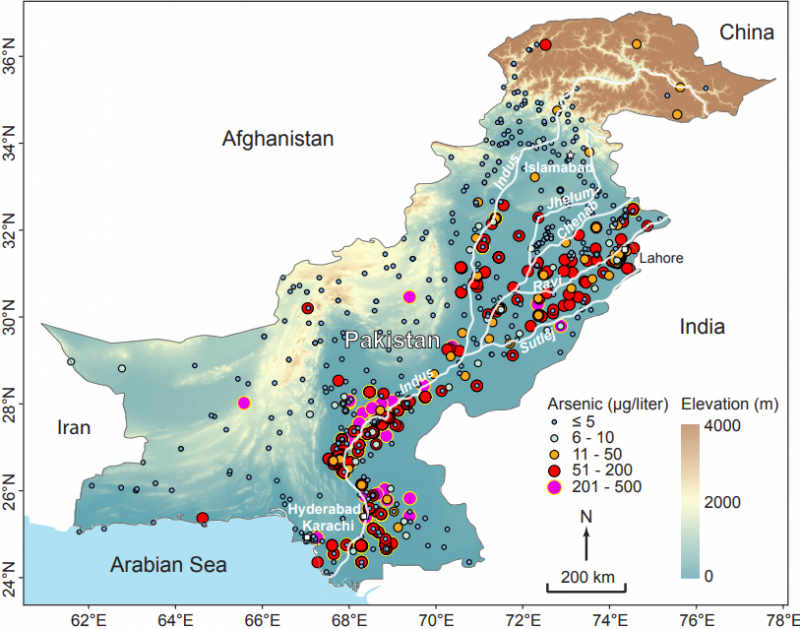Toxic Groundwater Threatens 60 Million in Pakistan
Published on by Water Network Research, Official research team of The Water Network in Academic
Arsenic-contaminated groundwater used as drinking water or for irrigation may threaten the health of 50 to 60 million people in Pakistan.
This is shown by an Eawag-led study (Swiss Federal Institute of Aquatic Science and Technology) in which data from 1200 groundwater samples was analysed and combined with geological and hydrological parameters to generate a hazard map. This reveals for the first time the full extent of the risks to which the population of Pakistan is exposed.

Arsenic concentrations measured in groundwater across Pakistan. (Source: Eawag)
In addition, there is growing evidence that natural arsenic levels are increased by extensive irrigation.
In many parts of the densely populated plains along the Indus River and its tributaries, arsenic concentrations in groundwater supplies exceed the WHO guideline of 10 µg/litre. Very high concentrations, above 200 µg/litre, are found mainly in the south; the highest measured in this study was 500 µg/litre.
Problem possibly exacerbated by irrigation
Arsenic from natural sources can be dissolved in groundwater. Worldwide, according to WHO estimates, around 150 million people rely on groundwater contaminated with arsenic. The relevant processes occurring in aquifers vary according to the geological and hydrological conditions.
Concentrations of dissolved arsenic are known to be particularly high in fluvial sediments with abundant organic material and limited oxygen supplies, e.g. in the deltas of the Ganges (Bangladesh) or the Red River (Vietnam); here, arsenic bound to iron oxides is released as a result of the chemically reducing environment. In Pakistan, however, though sediment layers are present along the Indus, reducing conditions are largely lacking.
But the new study shows a strong correlation between elevated arsenic concentrations and high soil pH. Infiltration of irrigation water through alkaline topsoil and young alluvial sediments may thus contribute to arsenic enrichment in groundwater.
First author Joel Podgorski, a geophysicist at Eawag, stresses that this is still a hypothesis. It is supported by the fact that irrigated areas largely coincide with regions where elevated arsenic concentrations were measured by co-author Ali Shah of COMSATS (Islamabad).
Using a model incorporating topographical, geochemical and hydrological parameters, the researchers created a map which, for the first time, shows the probability of increased arsenic concentrations for the whole of Pakistan. Especially in eastern Punjab – which includes Lahore – and around Hyderabad, many people are exposed to a high risk of arsenic contamination; altogether, 50 to 60 million use groundwater which very likely contains more than 50 µg/litre.
Podgorski comments: “This is an alarmingly high number, which demonstrates the urgent need to test all drinking water wells in the Indus Plain.” In previous studies, sampling has only been conducted at the village level, and a comprehensive evaluation has not been possible owing to a lack of resources.
Mitigation measures required without delay
Now that the extent of the risk is known, what measures should be taken? Firstly, says Podgorski, water from wells in high-risk areas must be tested. Within a small area, actual concentrations of arsenic often vary widely, and local aquifer conditions cannot be predicted sufficiently accurately by modelling.
At the same time, the relationship between extensive irrigation, high soil pH and increased arsenic concentrations in groundwater demands further investigation. If the suspected direct link is confirmed, irrigation techniques would need to be adapted so as to counteract the evaporation and infiltration of irrigation water.
Lastly, in areas where groundwater is contaminated, alternative sources of water could be sought (e.g. in deeper-lying aquifers), or – as a last resort – arsenic removal methods could be adopted. At any rate, Podgorski concludes, there is an urgent need to promote awareness raising and coordination of the authorities’ efforts.
Read full article: EAWAG
Read full study here: Science
Media
Taxonomy
- Drinking Water Security
- Water Access
- Groundwater
- Pollution
- Access
- Water Supply
- Drinking Water Managment
- Drinking Water
- Groundwater Recharge
- Groundwater Assessment
- Groundwater Modeling
- Groundwater Pollution
- Groundwater Mapping
- Water Sanitation & Hygiene (WASH)